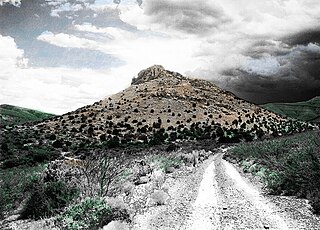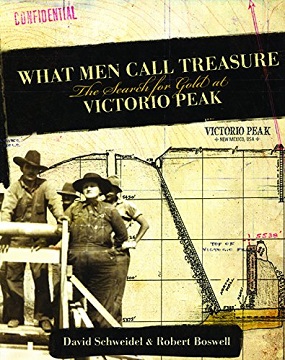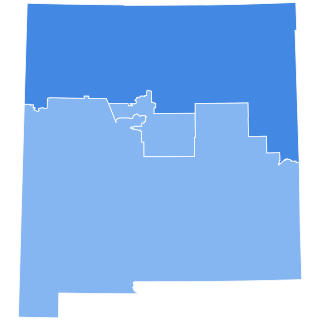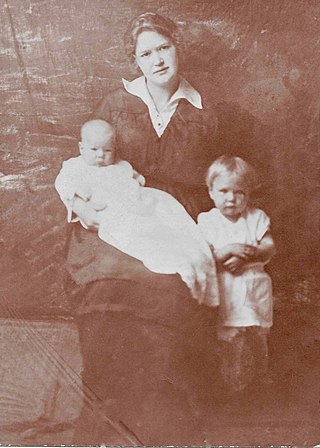
The Victorio Peak treasure (also seen in print as the Treasure of Victorio Peak or Treasure of San Andres) describes a cache of gold reportedly found inside Victorio Peak in 1937 in southern New Mexico.

The Victorio Peak treasure (also seen in print as the Treasure of Victorio Peak or Treasure of San Andres) describes a cache of gold reportedly found inside Victorio Peak in 1937 in southern New Mexico.
The treasure was allegedly found in 1937 by American businessman and gold prospector Milton Ernest "Doc" Noss. [1] [lower-alpha 1] While there have been multiple documented expeditions to the peak, no gold has been officially recorded as being recovered from the site. [3] Noss was ultimately killed by an associate, Charley Ryan, in 1949 after Ryan accused Noss of fraud and Noss allegedly threatened to kill Ryan and his family. [3] [lower-alpha 2]
A 1961 search by the U.S. Army—the peak lies within White Sands Missile Range—was stopped following a request to state officials by Noss's first wife, Ova. [5] She later was part of an unsuccessful 1963 search. [5] During the 1970s, lawyer F. Lee Bailey represented clients who claimed to know where the treasure was located. [6] [5] By 1992, a grandson of Ova formed the Ova Noss Family Partnership to finance additional searching. [5] The partnership conducted unsuccessful searches until March 1996, when the Army suspended their access. [7]
Theories abound on the origins of the alleged treasure, including that it was pilfered from Mexico during the reign of the Austrian puppet Emperor Maximilian, or through collusion between Pancho Villa and Germany prior to World War I. [8]
The reported treasure and efforts to find it have been covered in books and on television, including:

Victorio was a warrior and chief of the Warm Springs band of the Tchihendeh division of the central Apaches in what is now the American states of Texas, New Mexico, Arizona, and the Mexican states of Sonora and Chihuahua.

KOAT-TV is a television station in Albuquerque, New Mexico, United States, affiliated with ABC. Owned by Hearst Television, the station maintains studios on Carlisle Boulevard in Northeast Albuquerque, and its transmitter is located on Sandia Crest, northeast of Albuquerque. 27 repeaters carry its broadcast signal to much of New Mexico as well as southwestern Colorado and northeastern Arizona.

KRWG-TV is a PBS member television station in Las Cruces, New Mexico, United States. The station is owned by the Regents of New Mexico State University. KRWG-TV's studios are located at Milton Hall on the NMSU campus in Las Cruces, and its transmitter is located atop Tortugas Mountain in central Doña Ana County. KRWG-TV's signal is relayed on low-power translator stations across southern New Mexico.

Victorio Peak is a high rocky outcropping in the Hembrillo Basin in southern New Mexico. This was one of Chief Victorio's hideouts, and was the site of a battle in 1880 between Victorio's Apaches and the U.S. Army Ninth Cavalry "Buffalo Soldiers." Additionally, an American gold prospector claimed to have found hidden treasure inside the Mountains in the late 1930s.
Thomas Atcitty was an American politician and educator who served in the New Mexico House of Representatives as a member of the Democratic Party, 2nd Vice President of the Navajo Nation, and briefly served as the 3rd President of the Navajo Nation. He was a member of the Navajo Nation.

The Roswell Museum was founded in 1936 and is located in Roswell, New Mexico, United States. The museum features exhibits about the art and history of the American Southwest, as well as the Robert H. Goddard laboratory.
Montezuma's treasure is a legendary buried treasure said to be located in the Casa Grande ruins or elsewhere in the Southwestern United States and Mexico. The legend is one of many treasure stories in American folklore. Thomas Penfield wrote, "There is not the slimmest thread of reality in this story which is common throughout Mexico and the southwestern United States. There are some puzzling aspects but the story, nevertheless, adds up to pure legend."

What Men Call Treasure: The Search for Gold at Victorio Peak is a 2008 non-fiction book by Robert Boswell and David Schweidel chronicling the search for gold treasure inside Victorio Peak, New Mexico.
Clovis Municipal School District, also known as Clovis Municipal Schools, is a school district in Clovis, New Mexico, United States.
The Deming Headlight is a newspaper in Deming, New Mexico, United States.
KOCT was a television station in Carlsbad, New Mexico, United States, which operated from 1956 to 2012.

The 2018 United States House of Representatives elections in New Mexico were held on November 6, 2018, to elect the three U.S. representatives from the state of New Mexico, one from each of the state's three congressional districts. The elections coincided with the gubernatorial election, as well as other elections to the House of Representatives, elections to the United States Senate and various state and local elections.

Emma Catalina Encinas Aguayo (also known as Emma Gutiérrez Suárez and Emma G. Suarez was the first Mexican woman to attain a pilot's license in her country. When she gave up flying, she became an interpreter and translator for several government offices and served the president Luis Echeverría and his family as their official translator. She also interpreted for the United Nations and served as the Director General of the Alliance of Pan American Round Tables for many years. She was the first honoree as Woman of the Year of the Pan American Alliance in 1967.
Albert Norris Johnson was an American politician who served as the mayor of Las Cruces, New Mexico. Johnson also received multiple gubernatorial appointments to state commissions. He was the first black person to serve as a mayor in New Mexico.
Wingate High School is a Native American high school in unincorporated McKinley County, New Mexico, operated by the Bureau of Indian Education (BIE). It has grades 9-12. It has a Fort Wingate postal address.

Susie Ashcraft Gregg Parks Kendrick was the telephone switchboard operator of the southern New Mexico town of Columbus, on the southern border of the United States. She alerted the contingent of the National Guard located in Deming, New Mexico, during the Battle of Columbus skirmish, on March 9, 1916, where Francisco "Pancho" Villa and an estimated 400 of his men planned to invade several small cities in southern New Mexico. She was recognized and celebrated for her actions, which may have saved lives in Columbus and the surrounding counties.
José A. Baca was an American politician from New Mexico. He served as the lieutenant governor of New Mexico from January 1, 1923, until his death on May 17, 1924.
James Brooks Jones, nicknamed "Jawbone", was an American politician from the US state of New Mexico. He served as the lieutenant governor of New Mexico from January 1, 1943, to January 1, 1947.
Victorio, was a warrior and chief of the Apaches in and around Texas and New Mexico.